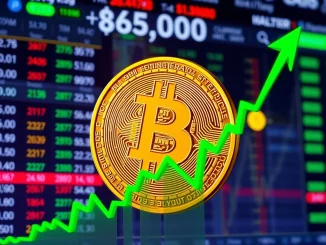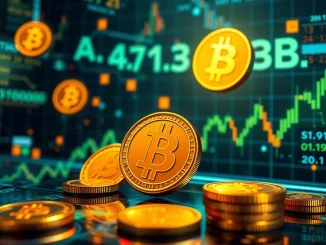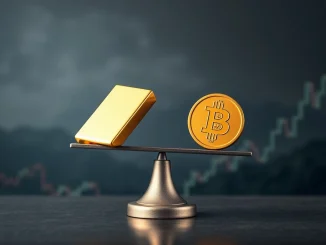
The cryptocurrency world is buzzing with discussions about digital asset reserves, especially in the context of national strategies. Recently, Samson Mow, CEO of Bitcoin technology firm Jan3, has sparked a crucial debate. He’s raising a significant alarm about the potential pitfalls of including altcoins in the U.S. strategic reserve. Could this seemingly innovative idea actually trigger market chaos? Let’s dive into Mow’s perspective and understand why he believes Bitcoin should be the cornerstone of any crypto reserve, leaving altcoins out of the equation.
Why Strategic Reserve Should Focus on Bitcoin, According to Samson Mow
Samson Mow, a prominent voice in the Bitcoin community, didn’t mince words when he shared his concerns on X (formerly Twitter). Referencing a Bitcoin.com News report, Mow reacted to the idea of a U.S. strategic reserve for cryptocurrencies, particularly in light of potential proposals from figures like Donald Trump. While acknowledging the transformative potential of such a reserve, Mow emphasized a critical condition for its success: the composition of the assets held.
Here’s a breakdown of Mow’s key arguments:
- Risk of Speculation: Mow argues that including altcoins like XRP, SOL, ADA, or ETH would fundamentally alter the nature of the reserve. Instead of a strategic asset, it would devolve into a “pure speculation game.” This shift in focus could undermine the reserve’s intended purpose and introduce unnecessary volatility.
- Lobbying and Insider Influence: Mow highlights the inherent danger of allowing political figures to handpick which cryptocurrencies are included. This opens the door to lobbying efforts and insider deals, potentially turning the strategic reserve into a “gift to lobbyists and insiders” rather than a robust financial tool.
- Importance of Proof-of-Work: Mow stresses the significance of prioritizing proof-of-work cryptocurrencies. He specifically mentions BTC, LTC, and XMR as assets that align with the principles of a sound strategic reserve, emphasizing their established security and decentralized nature.

The Allure and Peril of Altcoins in a Strategic Reserve
The crypto market is vast and diverse, with thousands of altcoins vying for attention and adoption. Many altcoins present themselves as innovative solutions, offering different functionalities and technological approaches compared to Bitcoin. Proponents of including altcoins in a strategic reserve might argue for diversification and the potential to capitalize on the growth of promising projects. However, Mow’s warning sheds light on the inherent risks associated with this approach.
What are the potential benefits of including altcoins?
- Diversification (in theory): Including a range of assets could, in theory, offer diversification. However, Mow argues this is misguided in the context of a *strategic* reserve, where stability and reliability are paramount.
- Exposure to Innovation: Altcoins often represent newer technologies and use cases. A reserve could gain exposure to these innovations.
- Potential for Higher Returns (Speculative): Some altcoins may offer higher growth potential than Bitcoin, although this comes with significantly higher risk.
What are the challenges and dangers?
- Increased Volatility and Instability: Altcoins are generally more volatile than Bitcoin. Including them in a strategic reserve could inject significant instability, making the reserve itself less reliable. This could lead to the very market chaos Mow is warning against.
- Security Risks: Many altcoins have less established security and network resilience compared to Bitcoin, making them potentially more vulnerable to attacks and manipulation.
- Regulatory Uncertainty: The regulatory landscape for altcoins is often less clear than for Bitcoin. This uncertainty adds another layer of risk and complexity to including them in a strategic reserve.
- Centralization Concerns: Many altcoins are more centralized than Bitcoin, raising concerns about control and influence over the network.
- Lobbying and Manipulation: As Mow pointed out, the selection process for altcoins could easily become a target for lobbying and insider manipulation, compromising the integrity of the reserve.
Bitcoin’s Case for Primacy in a Crypto Strategic Reserve
Bitcoin, as the original and most established cryptocurrency, stands out as a unique asset in the digital realm. Mow’s emphasis on proof-of-work assets like Bitcoin, Litecoin (LTC), and Monero (XMR) underscores the importance of fundamental principles in building a robust strategic reserve. Let’s examine why Bitcoin, in particular, makes a compelling case for being the primary, if not sole, component of such a reserve.
Bitcoin: The Digital Gold Standard
| Feature | Bitcoin | Altcoins (Many) |
|---|---|---|
| Decentralization | Highly Decentralized | Often More Centralized |
| Security | Most Secure Crypto Network | Varying Levels of Security, Often Less Robust |
| Network Effect | Largest and Most Established | Smaller and Less Developed |
| Longevity and Track Record | Longest Track Record, Proven Resilience | Shorter History, Less Proven |
| Regulatory Clarity | Increasing Clarity in Major Jurisdictions | Often Less Regulatory Clarity |
| Proof-of-Work Consensus | Uses Proof-of-Work (PoW) | Many Use Proof-of-Stake (PoS) or Other Mechanisms |
As the table highlights, Bitcoin possesses characteristics that are crucial for a strategic reserve asset: strong decentralization, robust security, a proven track record, and increasing regulatory clarity. Its proof-of-work consensus mechanism, while debated for environmental concerns, is lauded for its security and resistance to censorship.
The Samson Mow Perspective: A Call for Prudence
Samson Mow’s warning is not just about technical specifications; it’s a call for prudence and strategic thinking in the realm of digital assets. His perspective urges policymakers to consider the fundamental nature of a strategic reserve. Is it meant to be a speculative investment portfolio, or a stable, reliable store of value and a tool for national economic security? Mow clearly advocates for the latter, and in his view, Bitcoin is the only cryptocurrency currently positioned to fulfill that role effectively.
Including altcoins in a U.S. strategic reserve, while potentially appealing on the surface for diversification or exposure to new technologies, carries significant risks. These risks range from increased market chaos and instability to the potential for manipulation and compromised security. Mow’s stance underscores the importance of prioritizing stability, security, and decentralization when considering digital assets for strategic purposes.
Actionable Insights and Conclusion
Samson Mow’s insights provide crucial considerations for anyone involved in cryptocurrency policy and investment, particularly in the context of national strategic reserves. Here are some actionable insights:
- Prioritize Bitcoin for Strategic Reserves: Focus on Bitcoin as the primary cryptocurrency for any strategic reserve due to its proven security, decentralization, and established network.
- Exercise Caution with Altcoins: Be extremely cautious about including altcoins in strategic reserves due to their inherent volatility, security risks, and regulatory uncertainties.
- Focus on Proof-of-Work: Consider proof-of-work cryptocurrencies like Bitcoin, Litecoin, and Monero for their robust security and censorship resistance.
- Maintain Transparency and Avoid Political Influence: Ensure a transparent and unbiased selection process for any cryptocurrency reserve, minimizing the potential for lobbying and political influence.
- Conduct Thorough Due Diligence: Rigorous due diligence is essential for any cryptocurrency considered for a strategic reserve, focusing on security, decentralization, and long-term viability.
In conclusion, Samson Mow’s warning serves as a critical reminder that not all cryptocurrencies are created equal, especially when it comes to the serious matter of national strategic reserves. While the allure of altcoins might be tempting, the potential for market chaos and compromised integrity should not be underestimated. For a truly robust and reliable crypto strategic reserve, the focus should remain firmly on Bitcoin and other proven, decentralized, proof-of-work assets. Ignoring this advice could be a risky gamble with potentially destabilizing consequences for the market and the intended purpose of the reserve itself.



